
AIBDF 2021
The 2021 Guangdong-Hong Kong-Macao Greater Bay Area Artificial Intelligence and Big Data Forum (AIBDF 2021) was successfully held in Zhuhai. The Forum was hosted by Association of Fundamental Computing Education in Chinese Universities and Guangdong Computer Academy (GDCA); organized by Guangdong Journalists Association, Ton-Bridge Medical, and AEIC; and co-organized by Zhuhai Computer Federation, Guangdong Polytechnic Normal University, Guangdong Polytechnic of Science and Technology, Zhuhai Software Industry Association, and Zhuhai High-tech Zone Biomedical and Medical Devices Association. The Forum is also sponsored by Phytium Technology Co., Ltd., Lifeng Technology (Guangzhou) Co., Ltd., Guangdong Xuanyuan Networks & Technology Co., Ltd., iFLYTEK, KITOP, and Bó Lè Associates; technically supported by Zhuhai Association of Science and Technology, Guangdong Federation of Industry and Commerce, Guangdong Academy of Social Sciences, and Guangdong Foundation of Promoting Science and Technology; and guided by Guangdong Provincial Association for Science and Technology as well as the Department of Science and Technology of Guangdong Province.
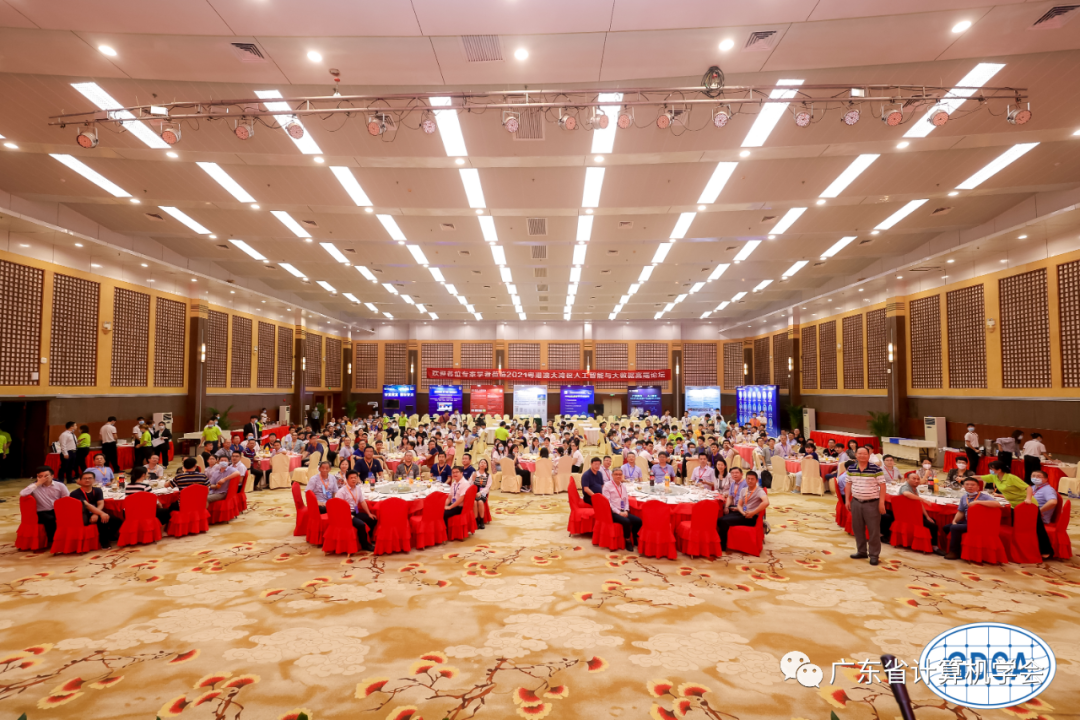
According to the 19th National Congress of the Communist Party of China, relevant parties and departments should work faster to build China into a manufacturer of quality and develop advanced manufacturing; promote further integration of the internet, big data, and artificial intelligence with the real economy; and foster new growth areas and drivers of growth in medium-high end consumption, innovation-driven development, the green and low-carbon economy, the sharing economy, modern supply chains, and human capital services.
Under this guide, Guangdong Computer Academy (GDCA) invited scholars from around the world to give speeches of next-generation information technology in regard to three special fields: AI, big data, and AI in healthcare. The Forum aimed to create a scholarly platform for cooperation and exchange, to foster technological development, as well as to promote technology integrations for socio-economic development in Zhuhai and Guangdong. Entrepreneurs from all over the world, together with university teachers and students, were also invited, which provides a strong impetus for academic exchanges and talent cultivation in Hong Kong, Macao, and Taiwan.
AIBDF 2021 has one main forum and three parallel parts.The main forum (AIBDF 2021) was held on September 25, and the parallel forums, including the AI+Health: Application and Future of Intelligent Healthcare, Academic Conference for Next-Generation Artificial Intelligence Technology in Guangdong-Hong Kong-Macao Greater Bay Area and Symposium on Automation, Artificial Intelligence and Electronic Information were held on September 26. The Forum invited Prof. Jian Weng, Vice Chair of Guangdong Computer Society, and Vice President of Jinan University; Jinming Wen, President of Macau Computer Society; and Xuan Huang, Senior Engineer, GDCA Secretary General to deliver speeches in the opening ceremony.
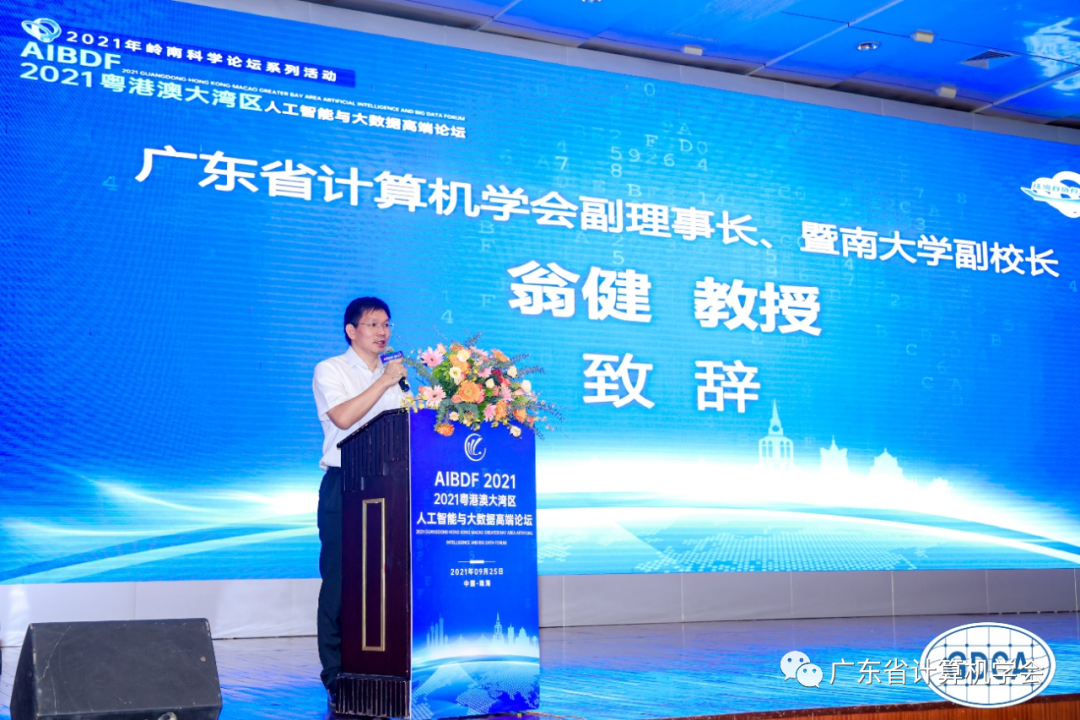
Welcome Speech by Prof. Jian Weng, GDCA Vice President and Deputy President at Jinan University
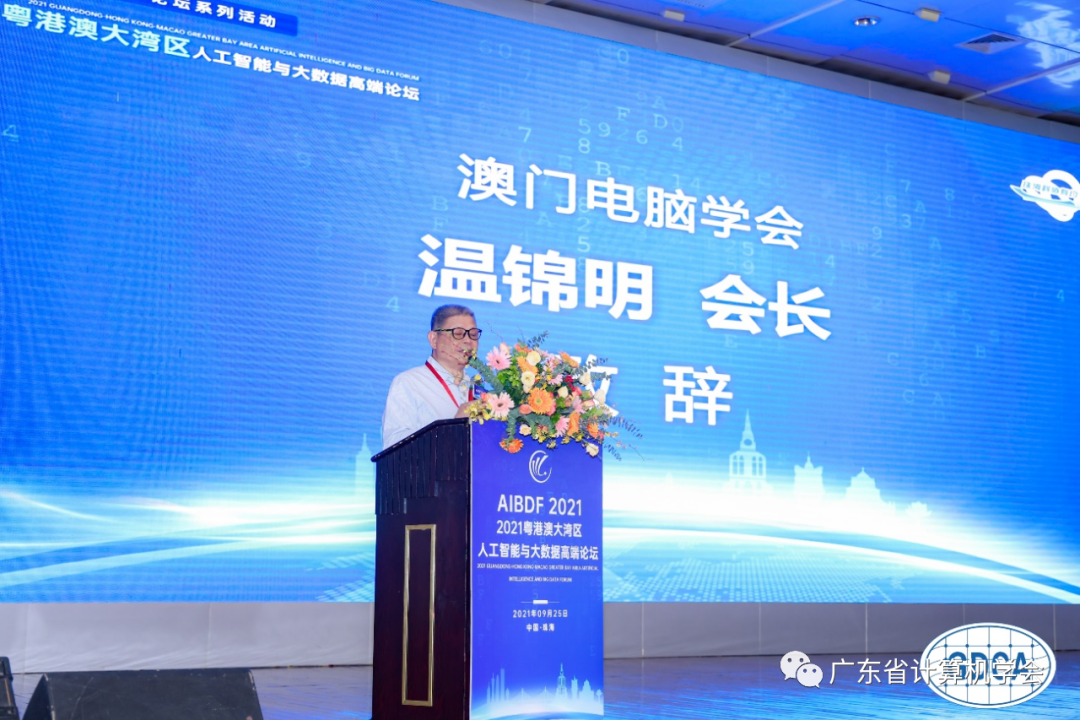
Welcome Speech by President Jinming Wen of Macau Computer Society
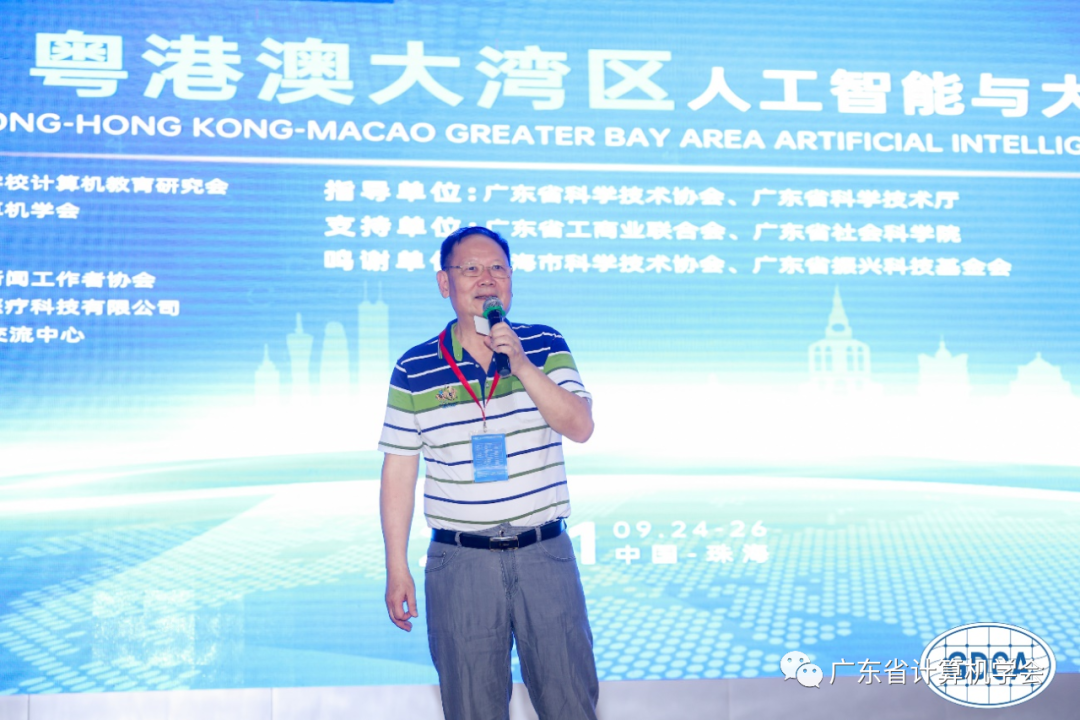
Welcome Speech by Xuan Huang, Senior Engineer, GDCA Vice Chair and Secretary General
Scholars, including Academician Guoliang Chen from Chinese Academy of Sciences (CAS); foreign academician of Academia Europaea; and Prof. Minyi Guo from Shanghai Jiaotong University, were then invited to give speeches. Besides, other famous experts or scholars were also invited to share their research findings or latest progress in the field of AI, big data, and AI in healthcare.
Guoliang Chen, currently a professor at Shenzhen University, elected as a CAS academician in 2003. He is an expert in parallel algorithms and high-performance computing. His report title is “Talking Something About Big Data”. He started from the development of human civilization and landmark technologies, and introduced the concept of big data, the emerging technology for the next frontier; then guided the audience to understand what big data is, including its definition, functions, challenges, and threats; finally, he concluded that big data could strengthen social development, as well as promote economic transformation. Big data can also provide a new opportunity to reshape national competitive advantage, he added.
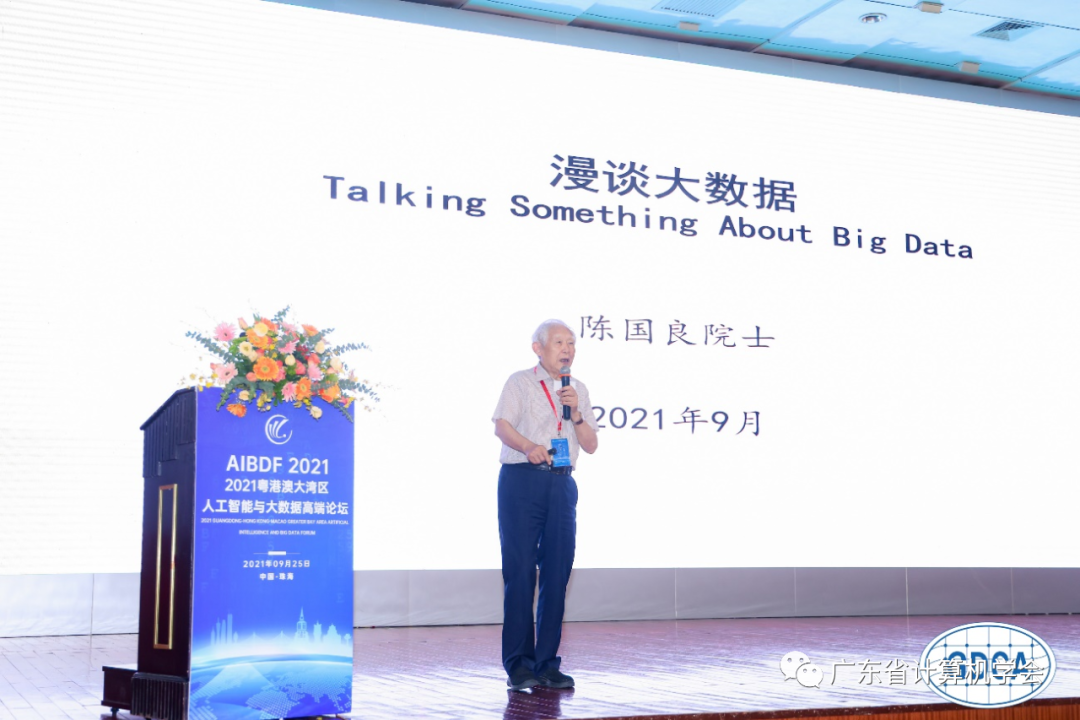
Speech by Academician Guoliang Chen
Minyi Guo is Foreign Fellow of Academia Europaea; Chair Professor of Shanghai Jiao Tong University; IEEE Fellow; and CCF Fellow. He talked about “A New Generation of Cloud Computing Driven by AI”. He pointed out that cloud computing is an important cornerstone of China’s digital transformation. IDC (International Data Corporation) predicts that by the end of 2021, 80% of all application deployments are expected to be cloud-based. For this reason, he said, traditional computing, with less elasticity and low flexibility, is no longer adapted to the current needs of China’s digital transformation. At the same time, AI-based applications such as autonomous driving and natural language processing have also put forward higher QoS requirements for cloud computing in terms of real-time functions and low latency. Hence, it was urgent to develop a new cloud computing technology, characterized by microservices and serverless computing. Based on this new technology, our research focuses would change; we needed to consider how to enhance the capability of AI-based applications under various conditions, such as mutational load, low throughput, and hybrid cloud deployment.
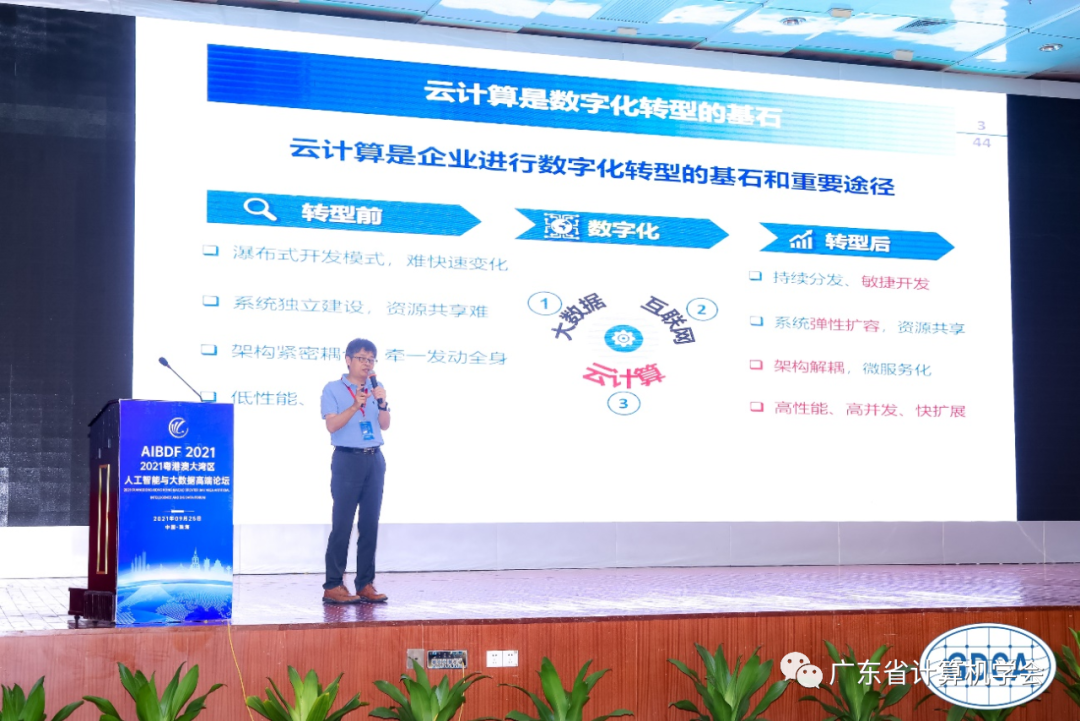
Speech by Academician Minyi Guo
Prof. Jianxin Wang, Dean of School of Computer Science and Engineering, Central South University, gave a speech on “Intelligent Analysis and Application of Biomedical Big Data”.Jianxin Wang is the chief scientist of “Information Processing Algorithms and Physical Realization”. He is currently conducting research on bioinformatics, optimization algorithms, network optimization theory, etc. In the speech, he mentioned that the advancement of informatization in hospitals and bio-detection technologies helped create a large biomedicine database. This is an opportunity for biomedical research to shift from the hypothesis-driven to a data-driven approach. Deep learning, a type of machine learning and artificial intelligence, has brought new light to biomedical data processing.
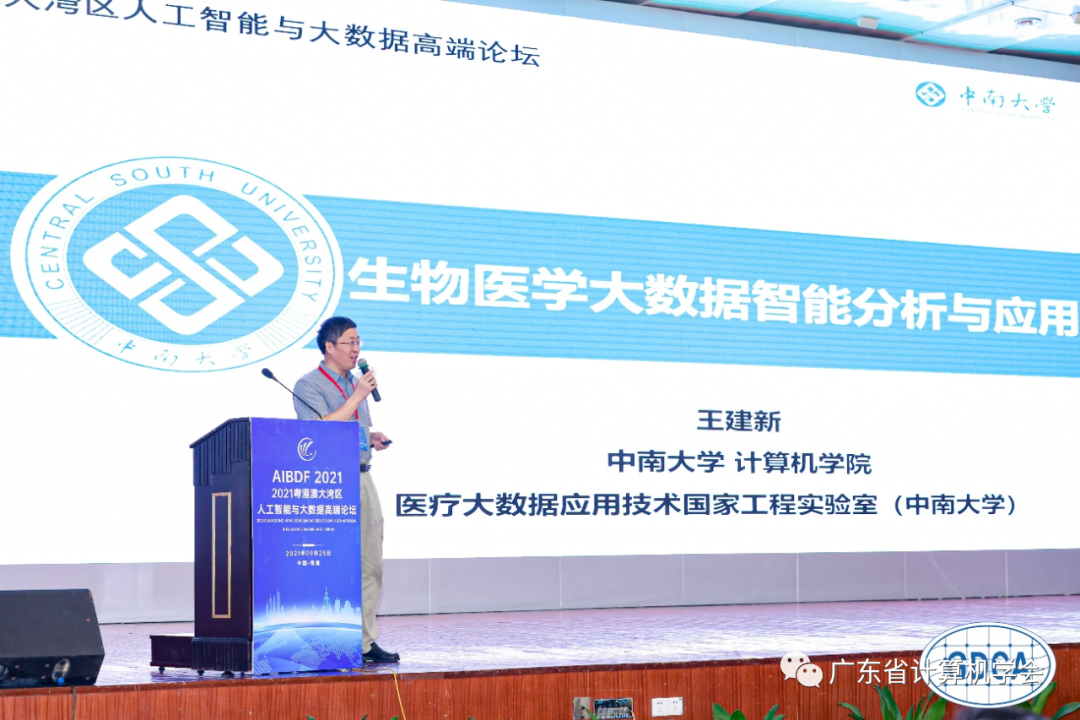
Speech by Prof. Jianxin Wang
Prof. Xuan Wang, Executive Dean of School of Computer Science and Technology, Harbin Institute of Technology (Shenzhen), gave a speech on “Decision Making with Incomplete Information and Its Application”. Prof. Wang said that game theory-based decision making is one of the important areas of artificial intelligence, and its complexity is closely related to the information complexity of the game environment, the strategy complexity, and the number of players. He introduced four key technologies, including in information perception and modeling, strategy solving, autonomous machine learning, and distributed parallel computing based on supercomputing. He has carried out various explorations around the application of gaming technology in the field of smart finance..
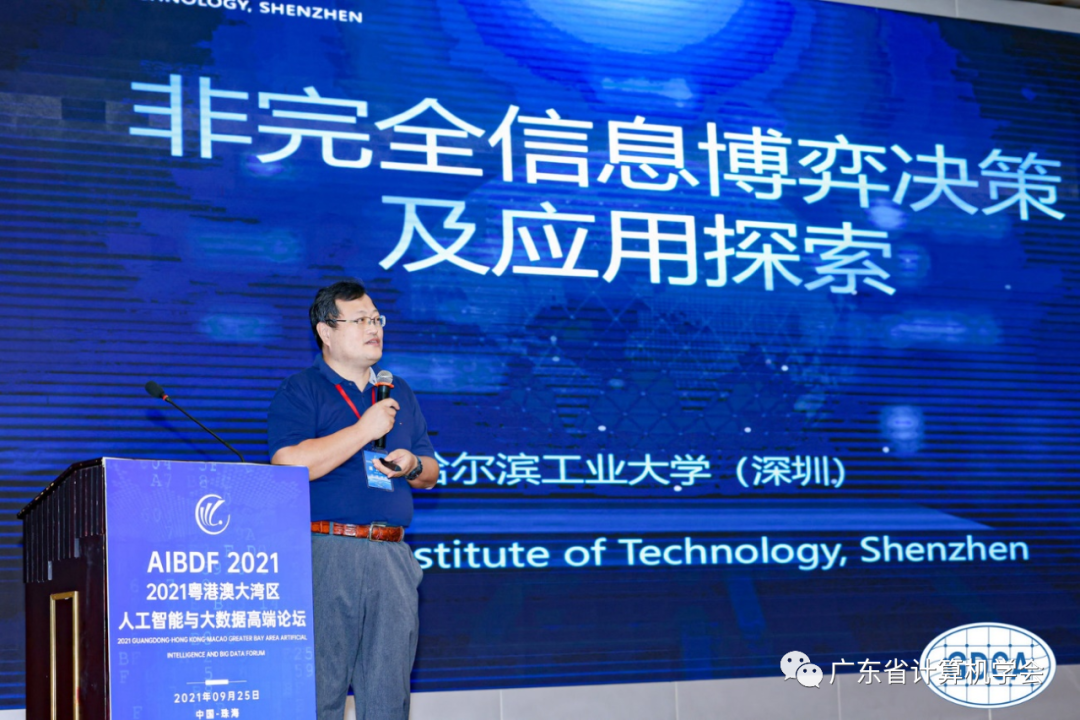
Speech by Prof. Xuan Wang
Prof. Jian Weng, Professor, Doctoral Supervisor and Vice President of Jinan University, gave his speech on “Quantum-Resistant Encryption”. He pointed out that, with the continuous development of quantum computers, traditional cryptography will face serious challenges. Prof. Weng first introduced the impact of quantum computers on the security of public-key cryptography and symmetric cryptography, and then introduced several mainstream cryptographic techniques that are currently being researched in the cryptography community that can resist attacks by quantum computers, focusing on the progress of lattice-based cryptography. He further also mentioned the standards for quantum-resistant cryptography and looked forward to what lies ahead in quantum-resistant computing cryptography.
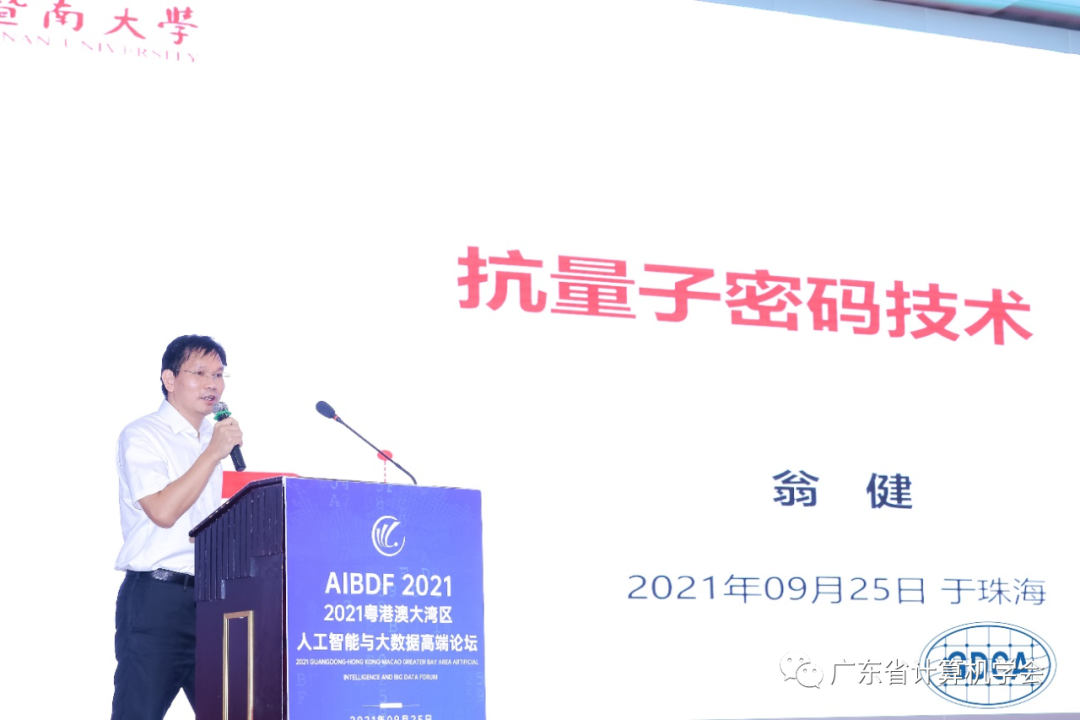
Speech by Prof. Jian Weng
Nong Xiao, Deputy Director of National Supercomputing Center in Guangzhou, Professor at the School of Computer Science and Engineering, Sun Yat-Sen University, gave a speech on “Network Computing Technology”. According to Prof. Xiao, network computing technology is an important computing model in the current development of computer technology, and is also a supporting system technology for big data and intelligent computing. The speech focused on a variety of network computing models and features, as well as their trends.
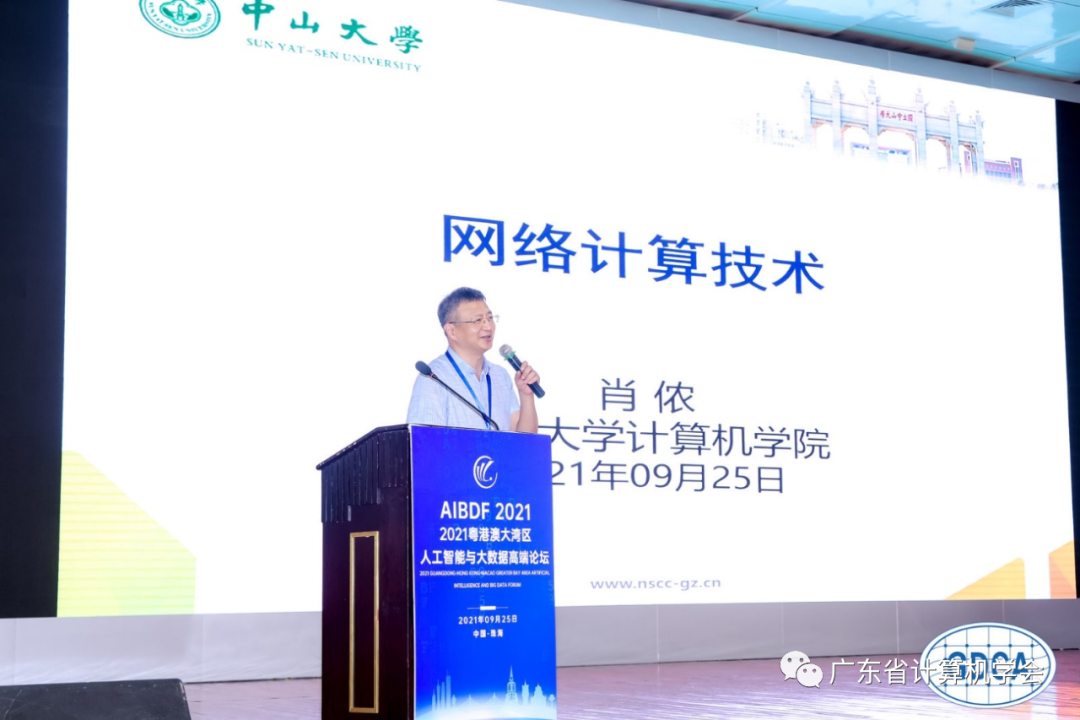
Speech by Prof. Nong Xiao
Prof. Anhui Liang from Shandong University of Science and Technology gave his speech entitled “Biological Optical AI and Bionic Optical AI Make It Possible for Robots to “See” Beauty”. Prof. Liang explained how the human eye work, and based on his research work, he was the first in the world to discover the bio-optical AI in the human eye and mammalian retina, as well as the golden ratio in color. He was the first in the world to propose a bionic optical AI that mimics the human eye, using fiber optic couplers and saturable absorbers to achieve optical AI, which is 100,000 times more energy efficient and significantly reduces latency than existing electrical AI. Not only that, Prof. Liang and his team were the first in the world to propose a robot that could “see” beauty.
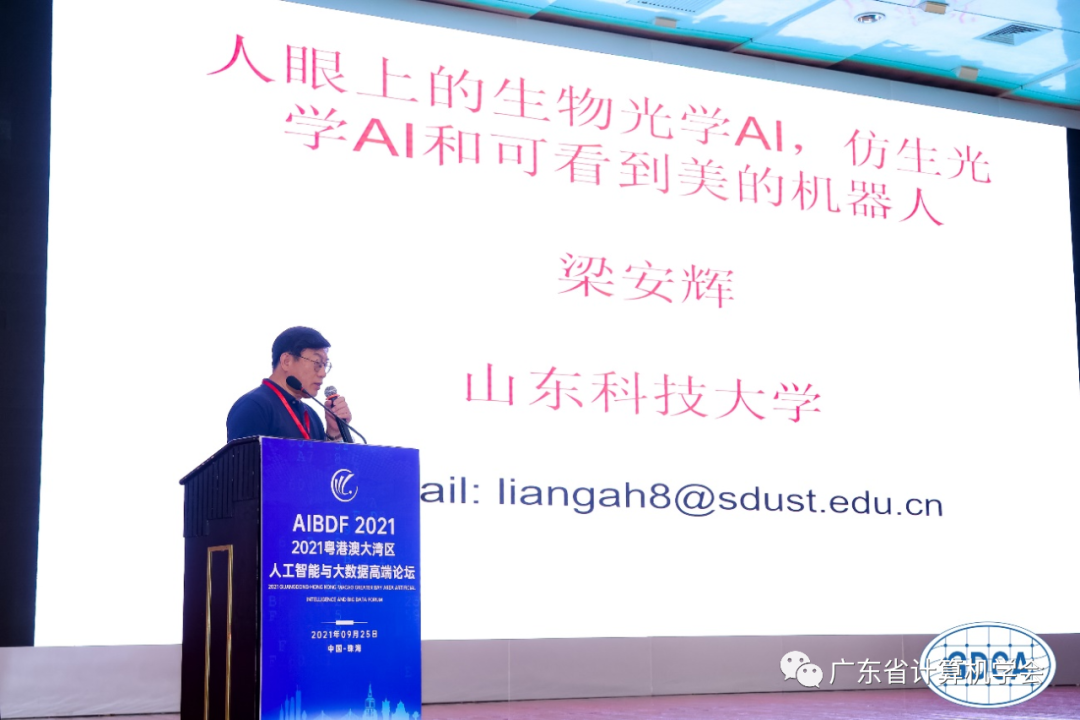
Speech by Prof. Anhui Liang
Tao Zhang, CASIC Chief Scientist, National High-Level Talents, and Professor at North China University of Technology, gave a speech on “Data Middle Platform and Application of City Brain”. Prof. Zhang stressed that City Brain is a smart platform that utilizes cloud computing, big data, artificial intelligence and IoT for urban management. As a brand-new infrastructure to support the sustainable development of future cities, City Brain is conducive to promoting digital transformation and upgrading in various fields such as urban governance, security, industrial development, and public services. City Brain can also improve the level of urban governance, and realize scientific, specific, and smart governance. City Brain utilizes rich urban data resources to conduct real-time analysis of cities, correct operational defects, and promote sustainable development, thereby realizing urban governance model, service model, as well as smart management.
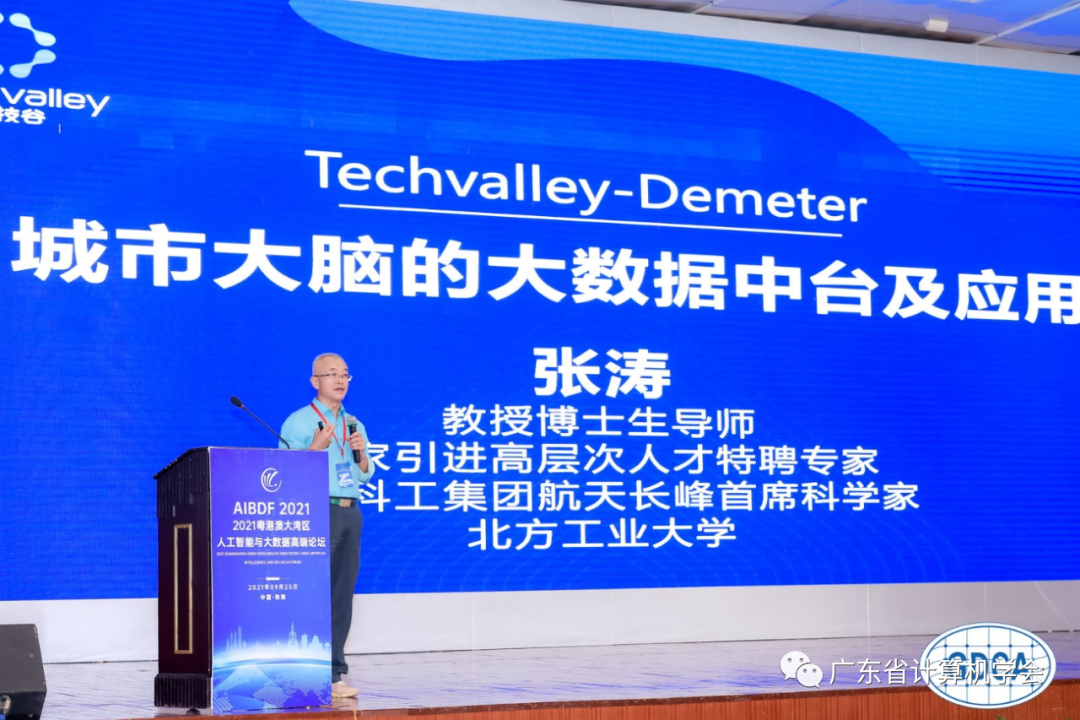
Speech by Prof. Tao Zhang
Yutong Lu, Director of National Supercomputing Center in Guangzhou, Professor at School of Computer Science and Engineering, Sun Yat-Sen University, gave a speech on “Supercomputing and Integrated Innovation”. Prof. Lu spoke about the rapid development of information technology and the leap in supercomputing technology driving the flourishing development of technology and applications in human society. The speech analyzed the combination of supercomputing and artificial intelligence, the features of core algorithms and popular applications; analyzed successful fusion application cases; discussed the trend of the next-generation system technologies; as well as the impact of the growing new demand for supercomputing applications on supercomputing architecture and software design. She also explored the balanced design technologies and platform software technologies for fusion applications and system collaboration, which has provided strong support for the sustainable development of China’s supercomputing applications, including artificial intelligence and big data.
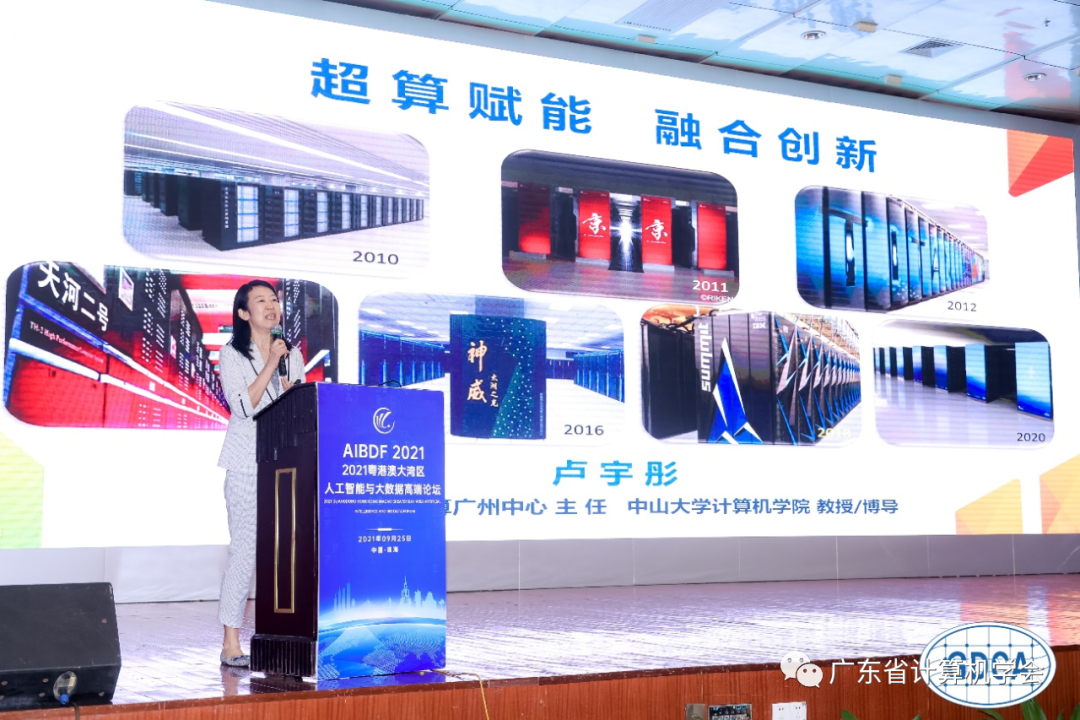
Speech by Prof. Yutong Lu—Supercomputing and Integrated Innovation
To promote business exchanges between Zhuhai and other regions, business elites from Phytium Technology Co., Ltd. and Guangdong Xuan Yuan Network & Technology Co., Ltd. were also invited. In their speeches, they shared their concepts and the demand for talents in the fields of corporate social responsibility, digital city and intelligent education.

Speech by Solutions Director Dayong Zhu, Guangzhou Phytium Technology—Phytium Technology Accelerates Intelligent Manufacturing in Various Industries
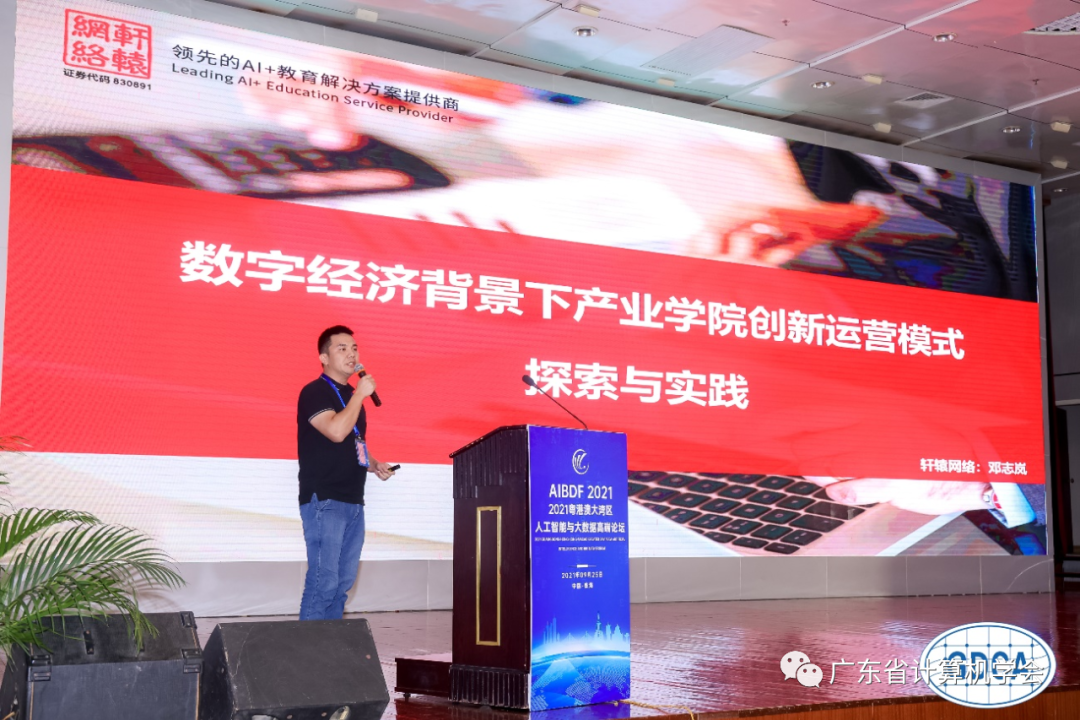
Speech by Zhilan Deng, Guangdong Xuanyuan Networks & Technology—Operational Innovations and Their Practice for Industry College under the Context of Digital Economy
In addition to the exciting academic sharing at the main forum, we also invited experts from all over the world to share their academic insights the following day in the panel sessions themed “AI + Healthcare: Application and Future of Intelligent Healthcare,” “Academic Exchange Conference on New Generation of Artificial Intelligence Technology in the Guangdong-Hong Kong-Macao Greater Bay Area,” and “International Symposium on Automation, Artificial Intelligence, and Electronic Information.” Assoc. Prof. Zhengtian Fang from the University of Macau, Prof. Yong Liang from the Macau University of Science and Technology, and Dr. Zhong Zhao from Zhuhai Tongqiao Medical Technology Co., Ltd. were invited to report on the panel session “AI + Healthcare: Application and Future of Intelligent Healthcare.”
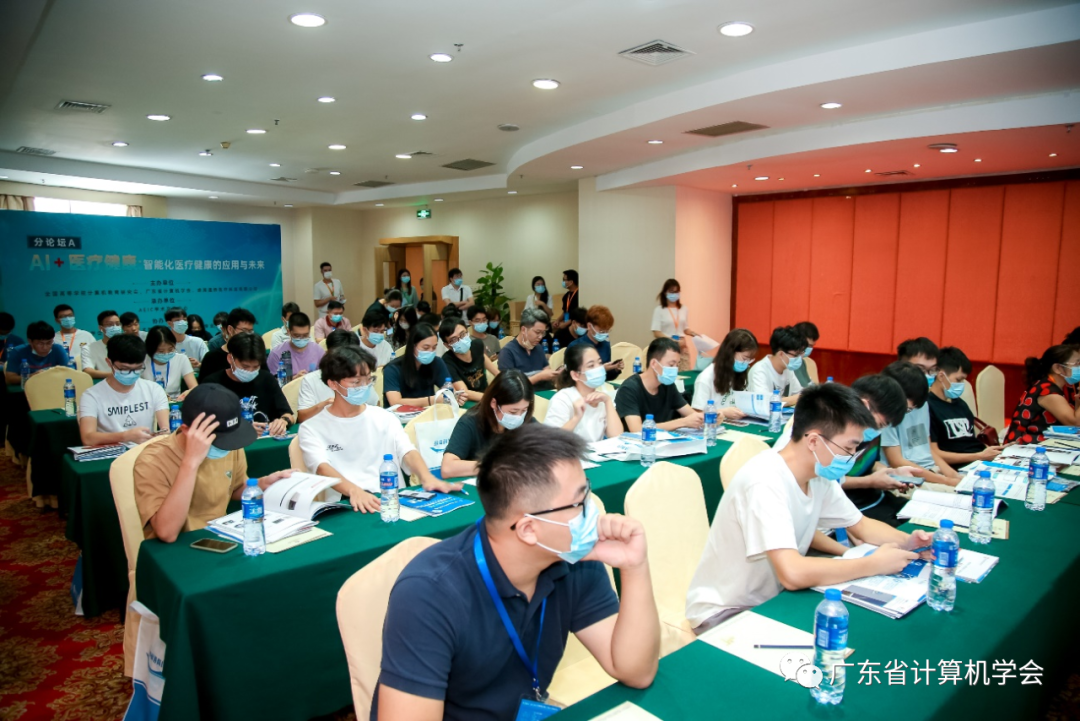
Panel Session A “AI + Healthcare: Application and Future of Intelligent Healthcare”
Assoc. Prof. Zhengtian Fang from the University of Macau gave a presentation on “Early Gastric Cancer Detection by Deep Learning.” Fang said early cancer detection could be realized by fusing longitudinal big data and personalized data on tumor growth dynamics from biomarkers. His presentation pointed out that AI is only the algorithm for making predictions, and it is difficult to effectively solve the current problems using AI alone. The method for early cancer detection proposed by his team has four components: a specialized imaging device with ultra-high resolution, conventional imaging + nanotechnology-based biosensor, conventional imaging + blood test results, and conventional imaging + tumor growth dynamic modeling/prediction, which will work together in the system.
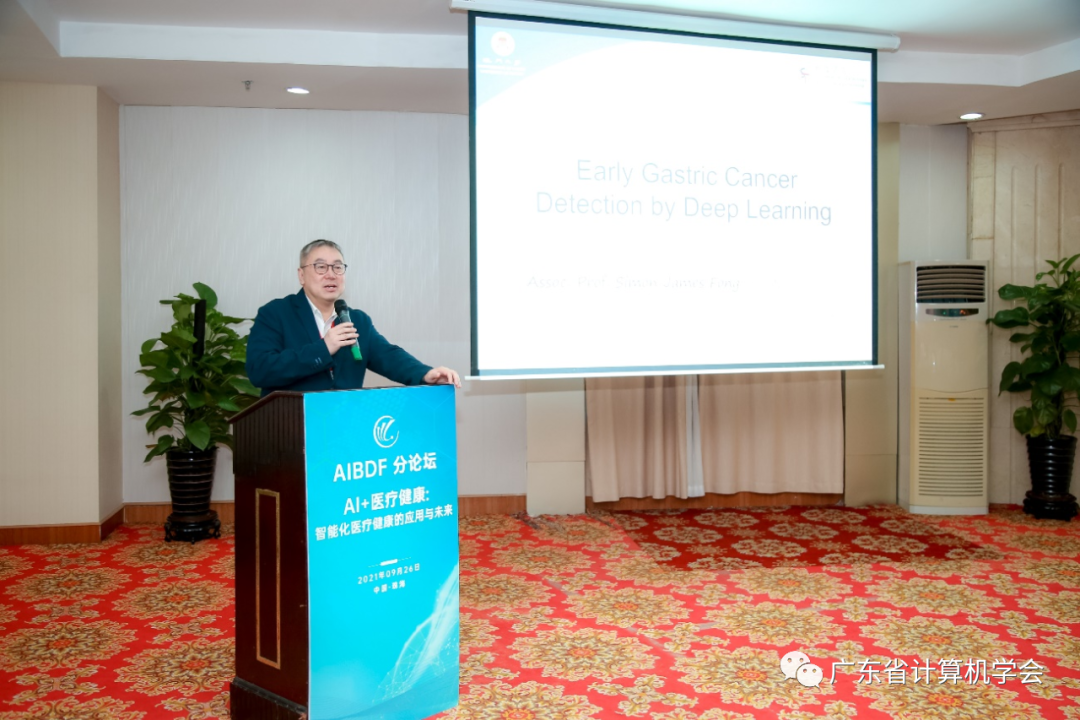
Assoc. Prof. Zhengtian Fang Giving Presentation on Early Gastric Cancer Detection by Deep Learning
Prof. Yong Liang from Macau University of Science and Technology gave a speech on “Research and Application of Machine Learning Methods in Biomedical Big Data Analysis.” Liang said that the accumulation of various biomedical big data, artificial intelligence, and big data analysis methods have great application potential in innovative drug development and diagnosis and treatment of complex diseases. By integrating multi-omics big data, as well as multi-source heterogeneous big data such as drug, chemical, clinical and environmental data, we can systematically analyze the mechanism of disease occurrence and development and biomarkers, determine the best drug target and select the most suitable drug type and dose, which is a key requirement of precision medicine and an essential development direction of intelligent medicine, and will provide important guidance for disease diagnosis, personalized treatment and precision drug use in clinical practice. The development of Macau’s traditional Chinese medicine (TCM) industry and the modernization of AI-assisted TCM are vital backups to the moderate and diversified development of its economy.
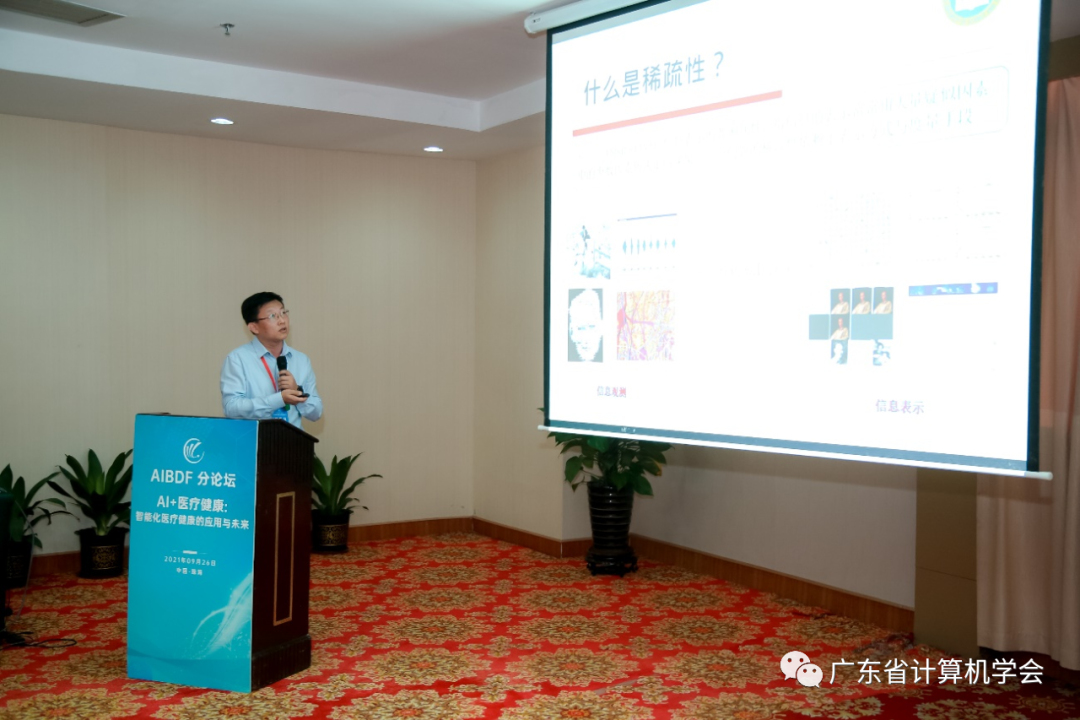
Prof. Yong Liang Giving Presentation on Research and Application of Machine Learning Methods in Biomedical Big Data Analysis
Dr. Zhong Zhao from Zhuhai Tongqiao Medical Technology Co., Ltd. gave a speech on “Prospects for Application of Artificial Intelligence in Neurointerventional Therapy.” Dr. Zhao said that whether artificial intelligence robots could gradually replace humans to diagnose and treat diseases is currently a hot topic of global research. The application of computer image analysis, industrial automation, and intelligent control has driven the development of AI-assisted therapy and led to its gradual application in microsurgery and interventional therapy with radiation damage, which require high precision and stability. In his presentation, Zhao introduced the current status of AI applications in cerebrovascular disease diagnosis, especially the application of interventional surgery robots in neurointerventional diagnosis and treatment, and gave an outlook on the future of AI applications.
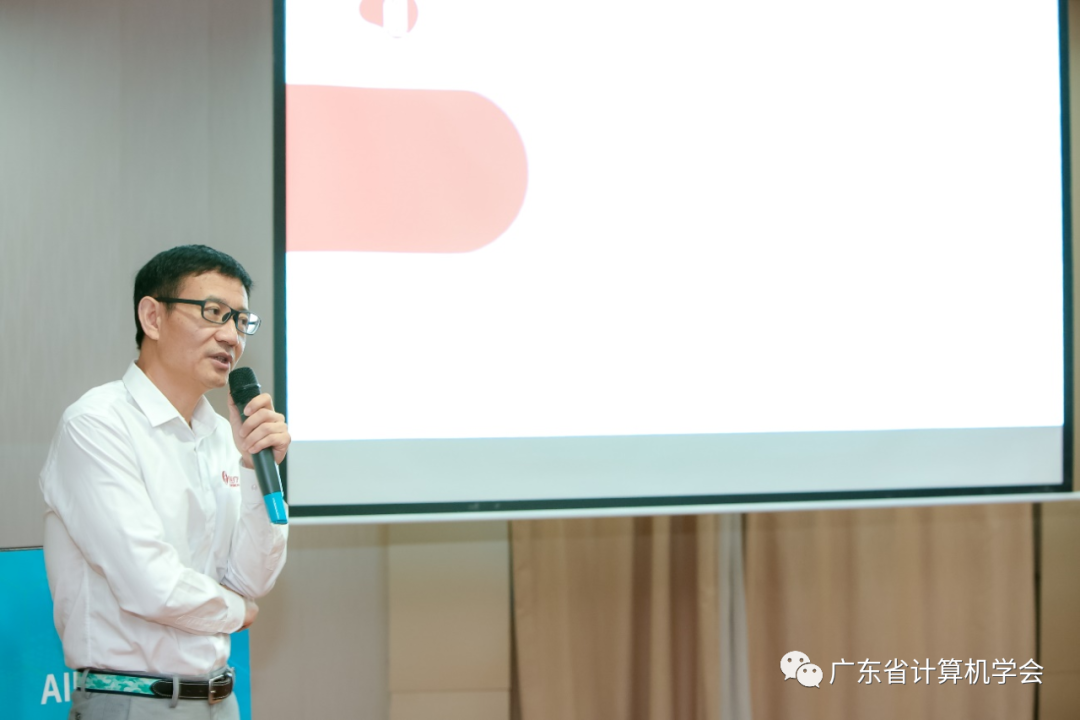
Dr. Zhong Zhao Giving Presentation on Prospects for Application of Artificial Intelligence in Neurointerventional Therapy
Panel Session B “Academic Exchange Conference on New Generation of Artificial Intelligence Technology in the Guangdong-Hong Kong-Macao Greater Bay Area” invited Assoc. Profs. Libin Zheng and Jianxing Yu and Asst. Prof. Xiaobin Chang from Sun Yat-sen University, as well as Prof. Guoqiang Zhong from the Ocean University of China to give presentations.
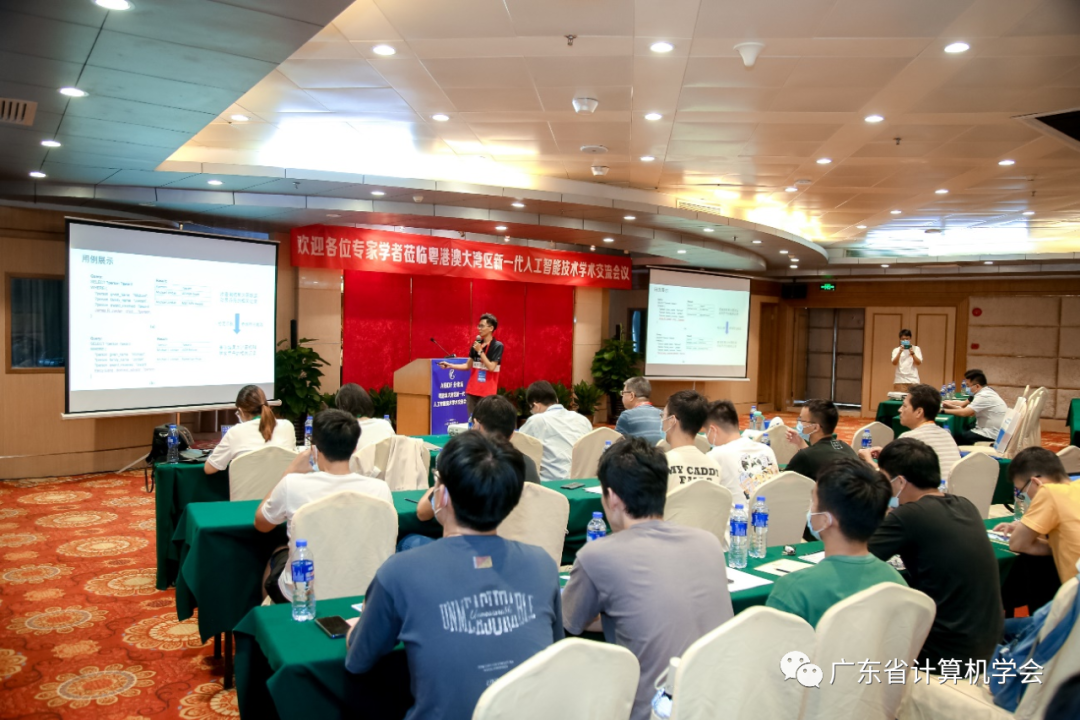
Panel Session B “Academic Exchange Conference on New Generation of Artificial Intelligence Technology in the Guangdong-Hong Kong-Macao Greater Bay Area”
Assoc. Prof. Libin Zheng from Sun Yat-sen University report on “Crowdsourcing Correction and Intelligent Querying of Knowledge Graphs.” He suggested that although the construction and querying of knowledge graphs have sparked widespread interest, it also has brought up challenges. In terms of construction, knowledge graphs often rely on unstructured multi-source text data and suffer from incorrect or inconsistent triad descriptions. Zheng pointed out that in the final stage of knowledge graph construction, the constructed triads are verified using crowdsourced computing methods to remove the errors and improve the quality. In terms of querying, the structure of the knowledge graph is more complex than traditional relational databases. Zheng and his team proposed SPARQL, a correction framework for the query language, to help novice users quickly write the correct query language to get the desired results.
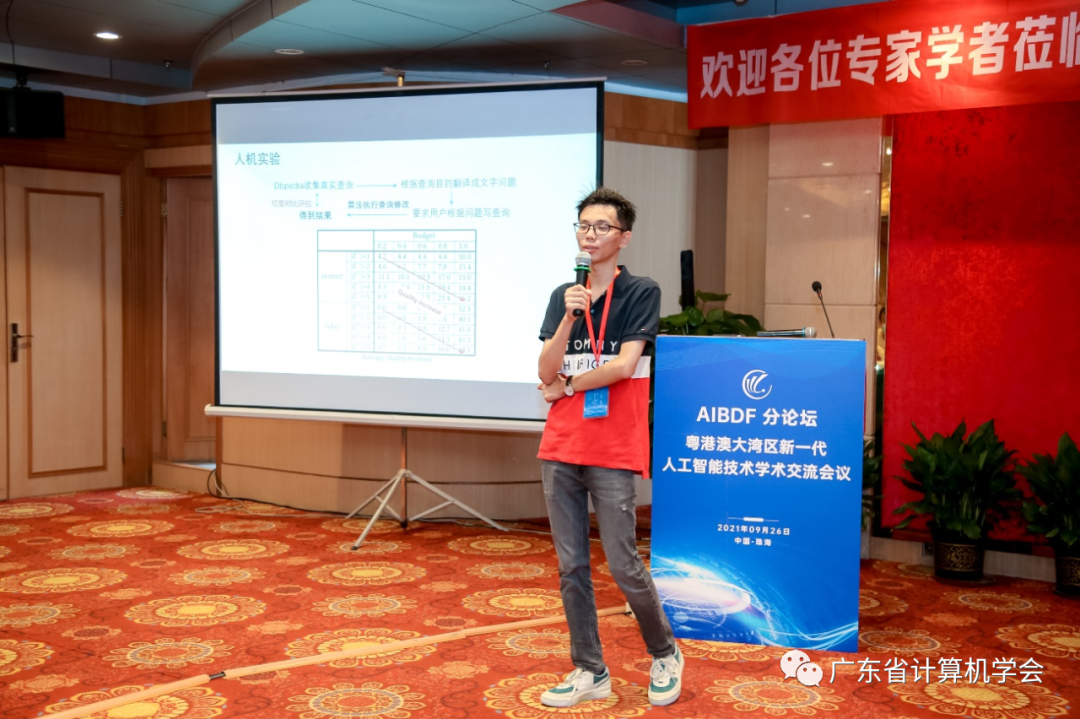
Assoc. Prof. Libin Zheng Giving Presentation on Crowdsourcing Correction and Intelligent Query of Knowledge Graphs
Assoc. Prof. Jianxing Yu from Sun Yat-sen University gave a speech on Knowledge-Based Text Reasoning and Question Answering Techniques. Question answering techniques allow machines to accurately generate answers by reading the language and understanding its semantics; yet users have diverse needs for information, so machines require not only basic retrieval capabilities, but also linguistic and cognitive abilities such as semantic understanding and logical reasoning, which are lacking in most existing models. In response to these difficulties, Assoc. Prof. Jianxing Yu and his team share a new method to capture logical associations for semantic understanding and text association reasoning, alleviate the problem of scarce training data, maximize the learning effect with only a small number of labels, and deploy across languages in an adaptable manner.

Assoc. Prof. Jianxing Yu Giving Presentation on Knowledge-based Text Reasoning and Question Answering Techniques
Asst. Prof. Xiaobin Chang from Sun Yat-sen University gave a speech on “Intelligent Recognition and Analysis of Video Data.” The recognition and analysis of video data is a key focus in the field of computer vision. In this speech, Chang discussed two of these topics with practical significance. The first is visual target tracking across scenes, which requires the proposed visual model to be highly robust and effective in reducing the impact of scene changes. In addition, the continuity feature of video data determines that the behaviors of people in the video are difficult to be segmented in an orderly manner. A model well-training can only be realized by fully labeled models with higher labor costs. The presentation also shares a video (temporal) segmentation algorithm based on weak labeling, which significantly reduces the usage of data labeling.
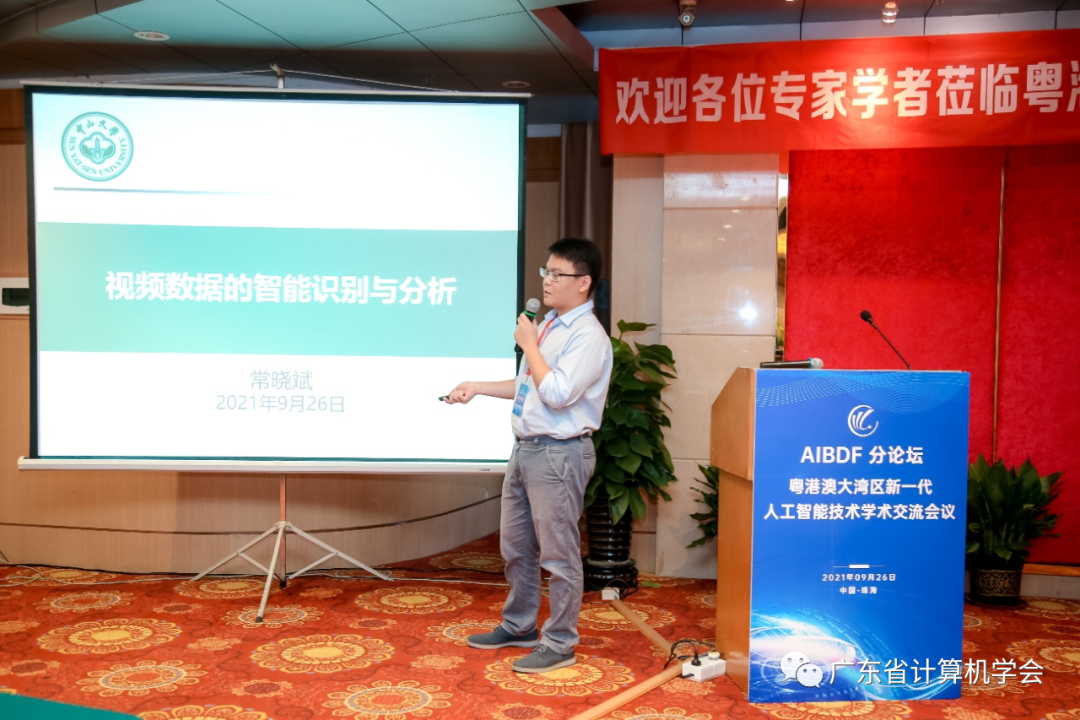
Asst. Prof. Xiaobin Chang Giving Presentation on Intelligent Recognition and Analysis of Video Data
Prof. Guoqiang Zhong from Ocean University of China gave a speech on “Automatic Design of Deep Neural Networks.” Deep neural networks (DNNs) have been widely used in fields such as pattern recognition and computer vision; however, the design of DNNs requires a great amount of expert knowledge to handle the large quantity of hyperparameters, and the structural design of DNNs is gradually changing from manual to automated methods. Prof. Guoqiang Zhong introduced some novel automatic design methods for DNNs, including DNA computing-inspired deep network design, neural blocks-based automatic design of deep networks, AutoML-based DenseNet compression, micro-lightweight architecture search, and generative neural architecture search. These methods provide a complete picture of the latest advances in the field of neural architecture search.
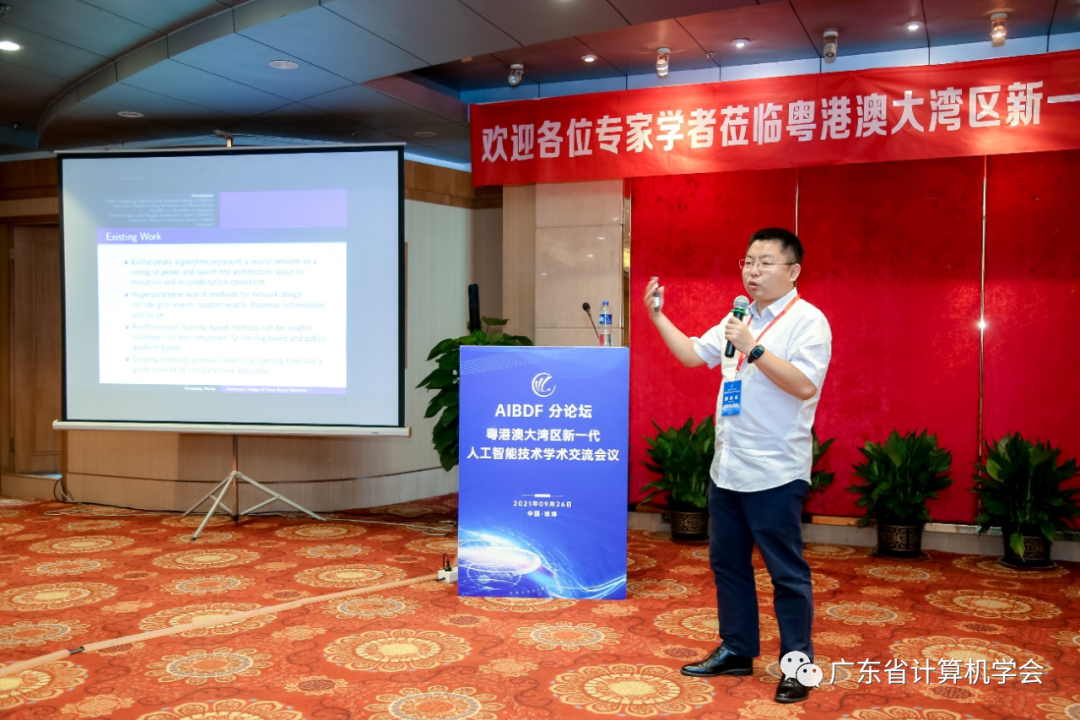
Prof. Guoqiang Zhong Giving Presentation on Automatic Design of Deep Neural Networks
Panel Session C “International Symposium on Automation, Artificial Intelligence and Electronic Information” invited Assoc. Profs. Yunxiao Shan and Xuehe Wang from Sun Yat-sen University and Prof. Yang Yue from Nankai University to give speeches.
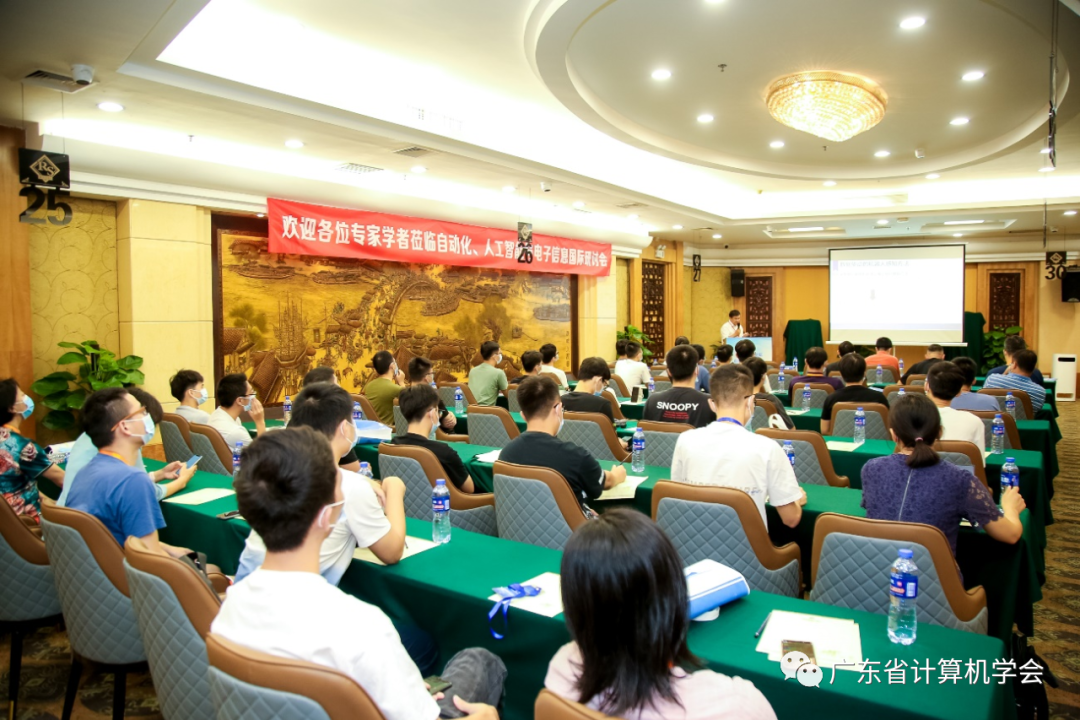
Panel Session C “International Symposium on Automation, Artificial Intelligence and Electronic Information”
Assoc. Prof. Yunxiao Shan from Sun Yat-sen University gave a presentation on “Data-driven Robot Systems.” Shan said that as robot systems and robot operating environments become more complex, a data-driven approach is emerging as an indispensable technology for robot sensing and control. However, data-driven approaches have insurmountable barriers in terms of interpretability and other aspects, whereas traditional methods based on optimization and rules are more advantageous in this regard. Therefore, how to combine the data-driven methods and the advantages of traditional methods in robot perception, planning, and control to realize the re-upgrade of robotic algorithms has become a new research hotspot.
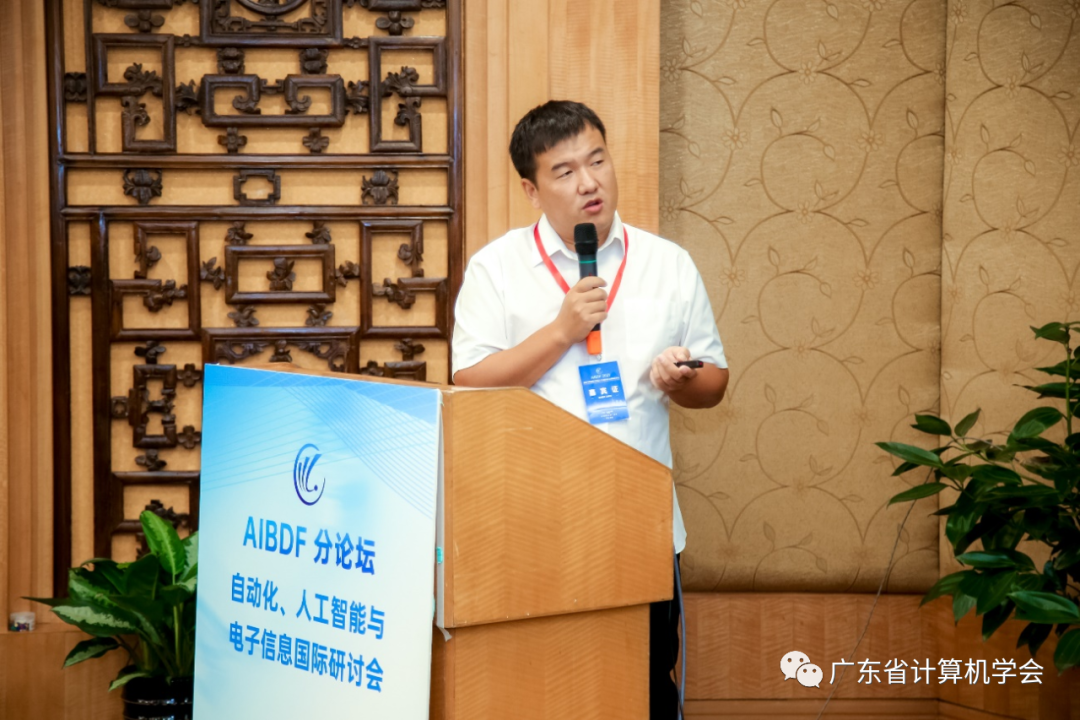
Prof. Yunxiao Shan Giving Presentation on Data-driven Robot System
Assoc. Prof. Xuehe Wang from Sun Yat-sen University gave a speech on “Design of Resource Trading and Reward Mechanism Based on Swarm Intelligence.” As mobile devices and applications develop rapidly, the connection between mobile users and service platforms is getting closer and closer. The use of swarm intelligence to assist the platform in completing tasks has greatly improved resource utilization and reduced platform costs. A great deal of current research has focused on how to design resource/task allocation algorithms to improve efficiency, but the motivation behind this crowdsourcing economy has been ignored. From the perspectives of platforms and users, Assoc. Prof. Wang discusses how selfish groups make decisions under incomplete information and how platforms should set up dynamic reward mechanisms to achieve long-term balance.
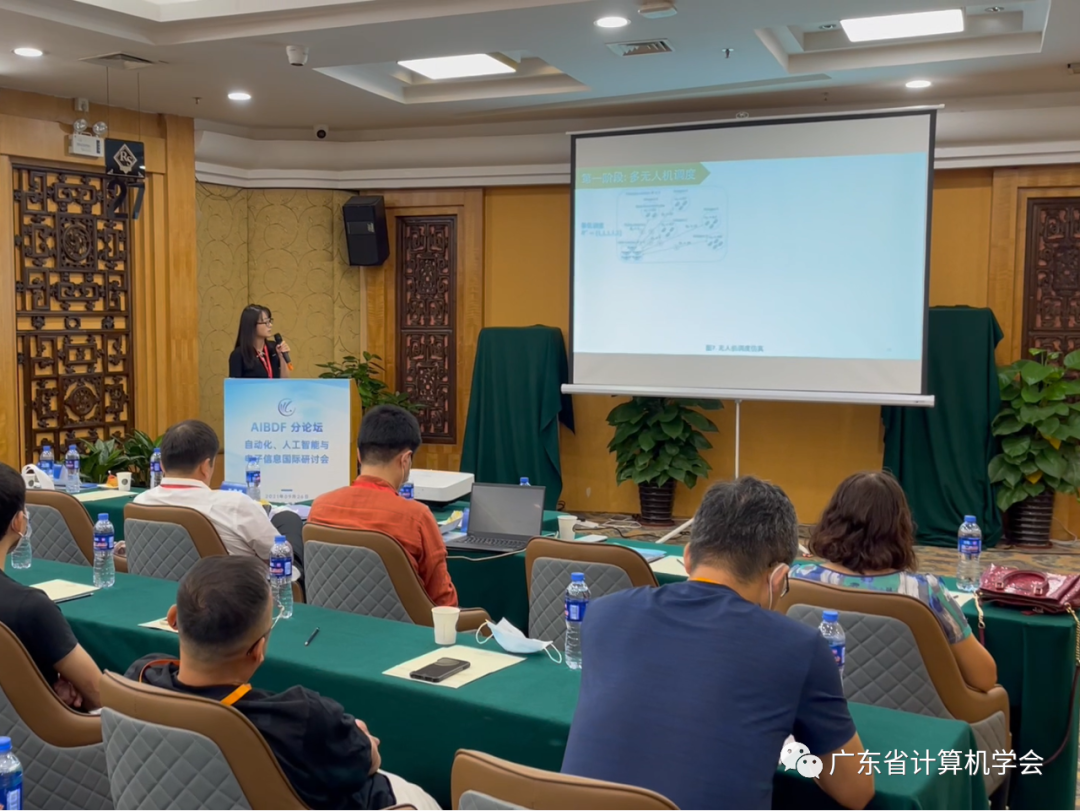
Assoc. Prof. Xuehe Wang Giving Presentation on Design of Resource Trading and Reward Mechanism Based on Swarm Intelligence
Prof. Yang Yue from Nankai University gave a speech on “Fiber Optic Communication Technology Based on Orbital Angular Momentum Mode-Division Multiplexing.” The application of vortex beams carrying orbital angular momentum (OAM) has made exciting progress in various fields, and OAM modes have attracted widespread attention in fiber optic communication. During the speech, Prof. Yue first introduced the basics of OAM and its various applications, including optical communications; then, he introduced several ring-core fibers for OAM modes, including multi-core ring-core fibers supporting thousands of OAM modes, etc. These ring-core fiber designs have great potential for improving the spectral efficiency and overall capacity of fiber-based communication systems.
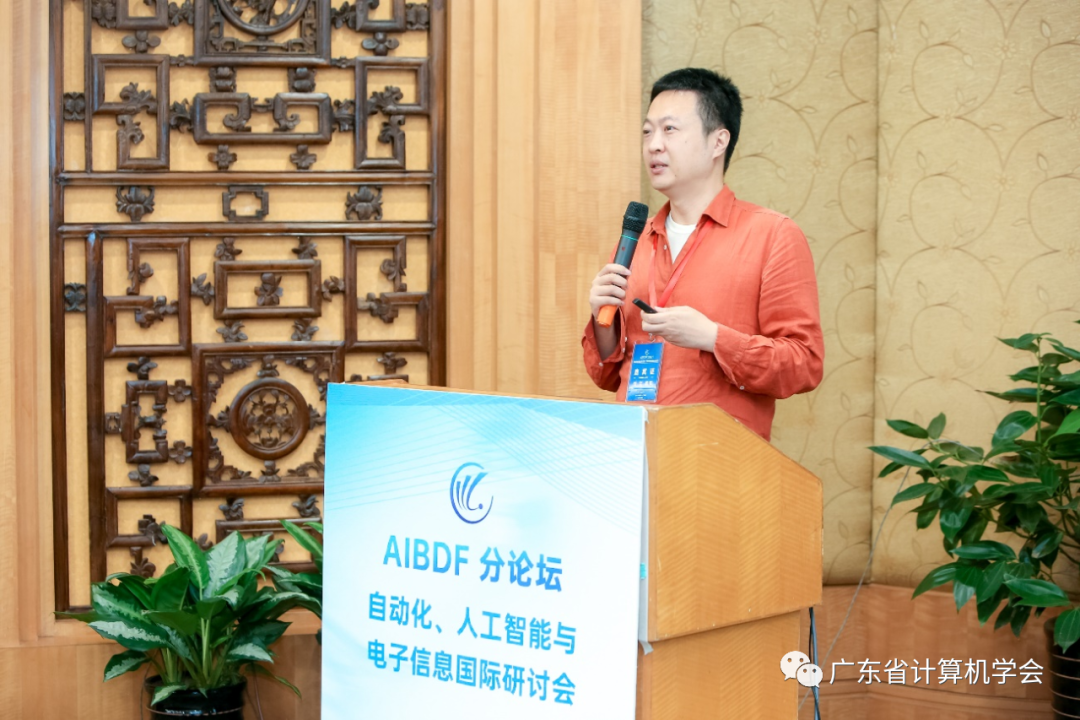
Prof. Yang Yue Giving Presentation on Fiber Optic Communication Technology Based on Orbital Angular Momentum Mode-Division Multiplexing